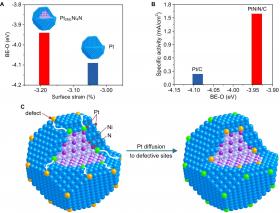Technologies Available for License
Categories: advanced materialsenergy
2012-040: Nitride Stabilized Core-Shell Nanoparticles
Invention: 2012-040
Patent Status: U.S. Patent Number 9,882,222 was issued on January 30, 2018
For technical and licensing related questions, email tcp@bnl.gov.
Summary

A) Comparison of surface strain versus predicted binding energy of oxygen (BE-O) on the Pt2MLNi4N and Pt nanoparticle models with ~1.7 nm. (B) Pt specific activity against BE-O on PtNiN/C and Pt/C. (C) Schematic of the inner Pt diffusion process to the defective sites at the vertex during cycling in the electrolyte. For clarity, the inner Pt atoms involved in diffusion are described in green, while the defects are in yellow.
Polymer electrolyte membrane (PEM) fuel cells offer exciting possibilities as alternative energy sources. The limiting reaction in these fuel cells is the oxygen reduction reaction (ORR) for which platinum is the best catalyst. Great strides have been made in reducing the overall amount of Pt required, and thus reducing the cost of the fuel cell, by coating a base metal nanoparticle core with a monolayer shell of Pt. Nevertheless, under voltage cycling conditions, as would be found in start-stop driving in a fuel cell electric vehicle, the core can dissolve, leaving the Pt shell vulnerable to dissolution itself. This invention addresses the challenge by stabilizing the core material against dissolution in the extremely acidic environment of a PEM fuel cell. During accelerated testing the stabilized core-shell nanocatalysts showed minimal (11mV) loss in half-wave potential over 35,000 cycles. The nanocatalysts also showed higher mass and specific activity than commercially available Pt/carbon catalysts.
Description
Nitride stabilized metal nanoparticles and methods for their manufacture are disclosed. In one embodiment the metal nanoparticles have a continuous and nonporous shell with a nitride-stabilized metal core. The nitride-stabilized core provides a stabilizing effect under high oxidizing conditions suppressing the noble-metal dissolution during potential cycling. The nitride stabilized nanoparticles may be fabricated by a process in which a core is coated with an ultrathin shell layer that encapsulates the entire core. Introduction of nitrogen into the core by annealing produces metal nitride(s) that are less susceptible to dissolution during potential cycling under high oxidizing conditions.
Benefits
This invention addresses the dissolution of Pt during start-stop driving conditions by stabilizing the core material in the extremely acidic environment of a PEM fuel cell. During accelerated testing the stabilized core-shell nanocatalysts showed minimal (11mV) loss in half-wave potential over 35,000 cycles. The nanocatalysts also showed higher mass and specific activity than commercially available Pt/carbon catalysts.
Applications and Industries
The first area of application of this technology will probably in fuel cells for electric and hybrid-electric vehicles. Fuel cells are also used for stationary applications such as backup power for telecommunications and combined heat and power systems.
Journal Publication & Intellectual Property
- Nitride Stabilized PtNi Core Shell Nanocatalyst for high Oxygen Reduction Activity (.pdf)
- US 9,882,222 (.pdf)
- US 10,501,321 (.pdf)
- US 10,680,249 (.pdf)
Tags: electrocatalystORR
Contacts
-

Poornima Upadhya
Manager Technology Transfer & Commercialization
Technology Commercialization
(631) 344-4711, pupadhya@bnl.gov
-

Avijit Sen
IP Licensing & Commercialization
Technology Commercialization
(631) 344-3752, asen@bnl.gov




